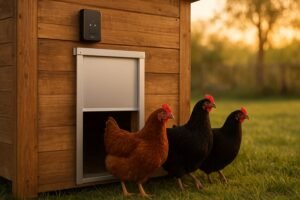Thinking about turning an old dog house into a chicken coop? Here’s what to know before you toss in the hens.
Got a dog house sitting empty? Wondering if your feathered friends could call it home? This guide shows you how to transform a dog house into a chicken coop. We’ll cover essential modifications, predator-proofing, and local rules. Let’s get to it.
Answer at a Glance: Can You Use a Dog House as a Chicken Coop?
Yes, with proper upgrades, a dog house can absolutely function as a small chicken coop. It’s a fantastic way to repurpose an existing structure, though it may not suit larger flocks or harsh climates without significant modifications. Think of it as a starter home for a few feathered friends. Best suited for mild climates or seasonal use unless insulated.
Why People Consider It: Pros & Cons
Building a coop from scratch felt daunting when I first considered chickens. That’s when the old dog house caught my eye. Many consider converting a dog house for similar reasons, but it has trade-offs. Can a dog house be a cheap chicken coop alternative? Absolutely, but be aware of the downsides.
Pros (Cost-saving, recycling, ready-to-use structure)
- Low Cost: Big savings compared to buying or building new. Free is always good. A great bargain for a new hobby.
- Recycling Materials: Repurposing feels great and is eco-friendly. There’s satisfaction in giving something a second life.
- Ready-to-Use Structure: Walls and a roof are already there. That’s half the battle won for beginners. It gives you a solid base.
Cons (Size limits, poor ventilation, predator risks)
- Size Limits: Most dog houses fit one dog, not multiple chickens. Space can be a major issue, especially for larger breeds. You’re likely limited to 1-3 smaller hens. A standard large dog house is around 7 sq ft—barely enough for two standard hens. If you’re dreaming of a sprawling flock, this might not be your forever solution.
- Poor Ventilation: Dog houses often lack adequate airflow, critical for chicken health. Without good ventilation, moisture and ammonia build up, leading to respiratory issues. A stuffy, smelly coop is no fun for anyone, especially your chickens!
- Predator Risks: Standard dog houses aren’t built to withstand determined predators like raccoons, foxes, or even neighborhood dogs. Gaps, flimsy doors, and lack of a secure floor are common vulnerabilities. It’s like leaving the cookie jar open – just asking for trouble!
For instance, I’ve seen stories on Reddit and sites like IWillTry.org where folks successfully converted dog houses for small breeds like Silkies or Bantams. It’s a budget-friendly recycle option, but it needs key modifications or is only suitable for a small flock. Don’t go into this thinking it’s just a quick paint job!

Essential Modifications to Make It Work
Converting a dog house isn’t just about moving it into the yard and adding chickens. You’ll need to make crucial changes. This is where the real work begins!
Ventilation – Adding vents/windows
This is non-negotiable. Chickens produce a lot of moisture. Without proper airflow, you’ll end up with a damp, smelly coop ripe for mold and respiratory problems. Lack of airflow is one of the top issues with dog house conversions. Bottom line? Good ventilation isn’t optional—it’s essential.
- Add Screened Vents: Put in at least two screened vents, one high near the roofline and one lower down. This creates a natural convection current, drawing fresh air in and pushing stale air out. Use hardware cloth (more on that later) over the openings to keep predators out. It’s all about that cross-breeze! For more details on avoiding common airflow issues, check out our guide on 17 Coop Ventilation Mistakes That Overheat Your Flock.
- Small Windows: If possible, think about adding a small, hinged window for extra airflow, always secured with hardware cloth. Give your chickens a safe peek at the outside world.
Raising on Legs/Stilts – Predator/damp prevention
Dog houses sit directly on the ground, a big no-no for a chicken coop. It’s like sleeping on a cold, wet basement floor – not ideal!
- Elevate 18-24 Inches: Lift the dog house off the ground using sturdy legs or stilts. This prevents dampness, makes it harder for digging predators to tunnel underneath, and improves airflow. I used some old concrete blocks and then secured wooden posts to them, creating a stable base. It felt like building a mini-fortress!
Roosting Bars & Nesting Boxes – Sleep and egg-laying basics
Chickens need specific places to sleep and lay eggs. They’re not just going to plop down anywhere!
- Roosting Bars: Put in a sturdy roosting bar inside, about 2 feet off the ground. Chickens naturally prefer to roost on a bar at night, as it makes them feel safe. A simple 2×2 piece of lumber with rounded edges works well. Give them a comfy perch, they’ll thank you with eggs!
- Nesting Boxes: Have at least one nesting box for every 3-4 hens. These don’t need to be fancy; a plastic tote or a small wooden box will do. Ideally, make them accessible from the outside with a hinged lid for easy egg collection. If external access isn’t possible, ensure you can still collect eggs without disturbing roosting birds. Reaching into a coop for eggs is way better than crawling inside!
Cleaning Access – Hinged roof, side door
You’ll clean this coop regularly, so make it easy on yourself. This is where you’ll either bless your past self or curse your lack of foresight!
- Hinged Roof: If your dog house has a flat roof, consider hinging it for full access. This makes cleaning out old bedding and scrubbing down the interior much simpler. It’s like having a convertible coop!
- Side Door: If a hinged roof isn’t feasible, add a small, latched side door large enough to reach in and clean. Aim for a design where you can clean the coop in under 10 minutes. Avoid designs where you have to struggle or awkwardly lift a heavy roof. Your back will thank you later. For tips on maintaining a healthy environment, consider reading about The Best Flooring for a Chicken Coop.
Predator Security & Weatherproofing
Your dog house truly becomes a fortress for your flock here. Don’t skimp! This isn’t just about keeping your chickens in; it’s about keeping the bad guys out.
Wire Mesh & Hardware Cloth – Dig-out defense
Chicken wire keeps chickens in; it doesn’t keep predators out. Hardware cloth does both. Think of hardware cloth as the bouncer for your coop – nothing gets past it!
- Hardware Cloth: This is your best friend. Use 1/2-inch or 1/4-inch galvanized hardware cloth to cover all openings, including vents, windows, and any gaps. It’s tough stuff, and predators hate it. Remember, chicken wire isn’t predator-proof. Use hardware cloth instead.
- Bury 12 Inches Deep: For ultimate dig-out defense, extend the hardware cloth horizontally outwards from the coop’s base and bury it at least 12 inches deep. This creates an apron that predators hit if they try to dig under. It’s a sneaky little trick that really pays off.
Securing Doors & Closing Off Gaps
- Heavy-Duty Latches: Replace flimsy latches with sturdy, predator-proof options. Spring-loaded latches or barrel bolts are good. For extra security, consider a padlock or carabiner clip. Use carabiners or spring-loaded latches—raccoons are clever and have nimble fingers! A simple hook-and-eye latch? Forget about it – a raccoon will have that open faster than you can say “egg.”
- Seal All Gaps: Raccoons can squeeze through surprisingly small openings. Inspect the entire structure and seal any gaps larger than 1/2 inch with hardware cloth, wood, or caulk. If you can stick your pinky finger through it, a predator can probably get in. For more comprehensive solutions, dive into What is the Best Predator Deterrent for Chickens? and Predator-Proofing 101: Easy Fixes for a Safer Coop.
Insulation vs Ventilation Balance
Keep your chickens comfortable, but not at the expense of fresh air. It’s a delicate dance!
- Cold Weather: In colder climates, consider adding insulation to the walls, but always ensure adequate ventilation. Frostbite is a risk, but so is respiratory illness from poor air quality. It’s a tricky balance, but your chickens’ health depends on it.
- Hot Weather: Good ventilation is paramount in hot weather to prevent overheating. The high and low vents are crucial here. Imagine being stuck in a hot box with no airflow – not pleasant!
Size, Space & Flock Limits
Understanding how much space chickens need is vital for their health and happiness. Crowded chickens are stressed chickens, and stressed chickens aren’t happy chickens (or good layers!).
Ideal House Dimensions per Hen
- Inside Coop: Aim for at least 4 square feet per standard-sized hen inside the coop. Larger breeds, like Orpingtons, need more, closer to 5 square feet. This space is for sleeping and egg-laying. For a 3-hen setup, you’d want at least 12 sq ft of interior space and 24–30 sq ft of run area. Give them room to stretch their wings! To plan your coop size perfectly, read our full guide on How Big Should a Chicken Coop Be?.
- Run Space: Beyond the coop, chickens need a secure outdoor run. Plan for 8-10 square feet per hen in the run. This is where they’ll forage, dust bathe, and generally be chickens. Curious about the pros and cons of different run setups? Check out Chicken Run vs. Free Range: Pros & Cons.
When to Use a Doghouse as Chicken Tractor
Because of their limited size, dog houses are often best suited for very small flocks (1-3 hens) or as a “chicken tractor.”
- Chicken Tractor: This is a movable coop without a fixed floor, allowing you to move your chickens to fresh patches of grass daily. A converted dog house on wheels can make an excellent small chicken tractor, providing fresh forage and natural pest control. A tractor-style coop helps control bugs and fertilize your yard naturally—just be sure it’s lightweight enough to move easily. This is a great option if you have a small yard or want to rotate your flock. It’s like a tiny, mobile chicken farm!
Legal Considerations and Local Rules
Before you even start swinging a hammer, check your local regulations. You don’t want to build a perfect coop only to find out it’s illegal. Nothing is more frustrating than wasted effort!
Zoning, Permits, Setbacks
- Zoning: Many urban and suburban areas have specific zoning laws regarding livestock. Some areas don’t allow chickens at all, while others have limits on the number of hens. Don’t assume anything – a quick call to your local city hall can save you a lot of grief.
- Permits: For small backyard coops (especially those housing fewer than 5 hens), you often don’t need a building permit, but this varies wildly by city and state. Do you need a permit for a backyard chicken coop? Often not—but always check with local authorities. Better safe than sorry! For a detailed look at regulations, explore our article on Chicken Laws by State.
- Setbacks: There are usually rules about how far a chicken coop must be from property lines, neighboring houses, and your own home (e.g., 10-20 feet from structures). Nobody wants their neighbor complaining about chicken smells or noises, right?
HOA Rules, Urban Ordinances
- HOA Rules: If you live in a Homeowners Association, their rules might be even stricter than city ordinances. Check your covenants carefully. HOAs can be surprisingly particular!
- Urban Ordinances: Cities often have specific rules about noise, odor, and waste management for backyard chickens. Even if hens are legal, cities may regulate noise (especially roosters), odor, and manure management. These ordinances help maintain peace between chicken owners and neighbors. Be a good neighbor and plan accordingly. A happy neighborhood means happy chickens!
Alternatives & DIY Plans
If a dog house conversion doesn’t quite fit your needs, or you’re looking for something different, there are plenty of other options. Don’t feel like this is your only path!
Portable Chicken Tractor
A chicken tractor is a fantastic alternative, especially for small flocks or if you want to integrate your chickens into garden pest control. They are designed to be moved regularly, providing fresh ground and reducing waste buildup. It’s a win-win for your garden and your chickens!
DIY Shed or Custom Build
- Shed Conversion: Many people convert small garden sheds into chicken coops. This offers more space and is often easier to modify for proper ventilation and cleaning access. If you’ve got an old shed gathering dust, this could be its new calling!
- Custom Build: If you’re handy, building a coop from scratch allows you to tailor it exactly to your flock’s size and your specific needs. Websites like The Spruce and BackYard Chickens offer numerous free DIY plans. The sky’s the limit if you’ve got the tools and the time!
Cheapest Coops to Buy
If DIY isn’t your thing, there are many affordable coops available for purchase. Look for ones that are easy to assemble, made from durable materials, and designed with good ventilation and predator protection in mind. Many under-$200 options exist at Tractor Supply or online retailers—just watch for poor ventilation. Sometimes, convenience is worth a few extra bucks. For budget-friendly building, check out How to Build a Chicken Coop for Under $200.
No matter your budget or skill level, there’s a way to house chickens safely—just choose the option that fits your flock and lifestyle.
Coop Comparison Table
Here’s a quick look at how different coop options stack up:
| Coop Type | Pros | Cons | Ideal Flock Size | Effort Level (DIY) | Predator Security (Out of 5) |
|---|---|---|---|---|---|
| Dog House Coop | Low cost, repurposes existing structure | Small, needs heavy modification, limited ventilation | 1-3 small hens | Medium | 2 |
| DIY Shed Coop | Customizable, spacious, good storage | High initial cost, requires building skills | 4-15 hens | High | 4 |
| Chicken Tractor | Mobile, fertilizes, pest control | Smaller capacity, needs frequent moving | 1-5 hens | Medium | 3 |
| Prebuilt Coop | Convenient, ready-to-use | Can be expensive, variable quality, less customizable | 1-10 hens | Low | 3 |
Expert Tips & Common Mistakes
Having gone through the process myself, I’ve learned a few things. Here are some tips and mistakes to avoid. Learn from my (and others’) triumphs and tribulations!
Top Mistake: Skipping ventilation or predator-proofing
This is the most common and most dangerous mistake. I once saw a friend’s coop (not a dog house, but the principle applies) that was poorly ventilated, and his chickens developed respiratory issues. Another time, a flimsy latch led to a devastating predator attack. Do NOT skimp on these two areas. Your flock’s health and safety depend on it. It’s truly heartbreaking when something goes wrong. For more insights, read about Mistakes Every First-Time Chicken Keeper Makes.
Top Tip: Don’t skimp on ventilation
Don’t reinvent the wheel. Look at documented conversions like the one on IWillTry.org. They often provide detailed photos and steps with step-by-step photos on raising the coop, improving access, and installing predator-proofing like hardware cloth. Learning from others’ experiences saves you time and prevents headaches. Why struggle when someone else has already figured it out?
How I raised Gus’s doghouse into my first coop
When I decided to get my first three hens, I inherited my neighbor’s old, sturdy doghouse. It was Gus’s old home, a classic wooden A-frame. My biggest challenge was getting it off the ground. I ended up using four concrete deck blocks as a base, then bolted 4×4 posts to them, raising the entire structure about 20 inches.
This not only kept it dry but also gave me a perfect spot to bury the hardware cloth apron, thwarting any digging predators. It wasn’t pretty at first, but it worked, and those hens were happy and safe. It taught me that sometimes, the simplest solutions are the most effective, especially when you’re just starting out. It was a proud moment, I won’t lie!
Quick FAQ on Can You Use a Dog House as a Chicken Coop
Can chickens live in a dog house?
Yes, chickens can live in a dog house. This is possible for 1-3 smaller hens, provided it undergoes essential modifications for ventilation, predator protection, and proper roosting/nesting areas.
How far must a chicken coop be from a house?
Typically, a chicken coop must be 10-20 feet from a house or property line. Specific setback requirements vary significantly by local city and county ordinances.
Do I need a permit?
A permit is usually not required for small backyard chicken coops housing fewer than 5 hens. However, it is crucial to check your specific city or county zoning and building regulations as rules vary.
Will dogs and chickens mix?
Dogs and chickens can mix. This requires proper training for the dog and secure barriers or supervision to ensure the chickens’ safety, as a dog’s prey drive can be unpredictable.
What can I use instead of a chicken coop?
Alternatives to a traditional chicken coop include portable chicken tractors, converted garden sheds, custom-built structures, or even large, secure dog kennels with modifications.
What is the best predator deterrent for chickens?
The best predator deterrent for chickens is robust physical security. This primarily involves using 1/2-inch or 1/4-inch hardware cloth, secure latches, and burying a hardware cloth apron around the coop’s base.
Can chickens go without a coop?
No, chickens cannot safely go without a coop. They need a secure, predator-proof shelter for protection from predators and the elements, especially at night.
Is it cheaper to make your own chicken coop?
Yes, generally it is cheaper to make your own chicken coop. This is especially true if you can repurpose materials, compared to buying a pre-built coop.
Can I transport chickens in a dog crate?
Yes, a dog crate can be used for temporary chicken transport. It must be well-ventilated, secure, and sized appropriately for the number of chickens.
How to make a dog proof chicken coop?
To make a chicken coop dog-proof, ensure all entry points have secure latches, use strong hardware cloth on openings, and supervise interactions if dogs are allowed near the coop.
Convert plastic dog house to chicken coop.
Converting a plastic dog house to a chicken coop requires adding ventilation holes, secure roosting bars, nesting boxes, and reinforcing openings with hardware cloth for predator protection.
Dog crate for broody hen.
A dog crate can serve as an excellent temporary broody hen “hospital” or isolation area. It provides a safe, quiet space for a hen to hatch eggs or recover without disturbance from the flock.
Can I use a dog kennel as a chicken run?
Yes, with proper shade and predator-proofing, a large dog kennel can double as a chicken run.

Oladepo Babatunde is the founder of ChickenStarter.com. He is a backyard chicken keeper and educator who specializes in helping beginners raise healthy flocks, particularly in warm climates. His expertise comes from years of hands-on experience building coops, treating common chicken ailments, and solving flock management issues. His own happy hens are a testament to his methods, laying 25-30 eggs weekly.



